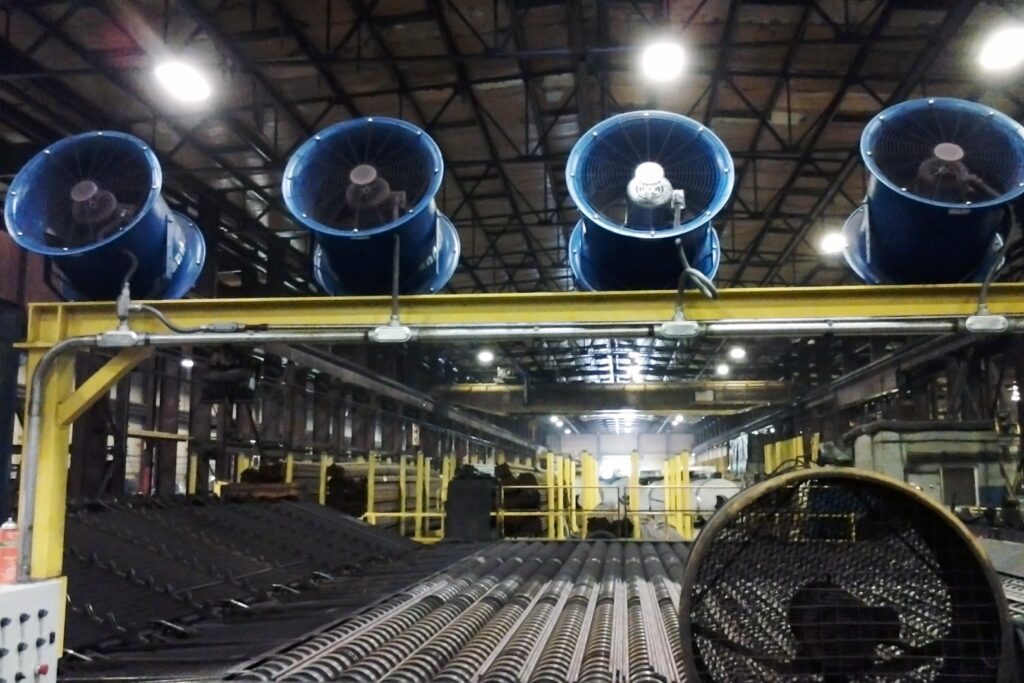Industrial fans play a crucial role in the material processing industry by providing essential air circulation, ventilation, and dust control in various processes. Their applications are vast and diverse, with each type of fan being suited for specific needs in different stages of production. Here’s a detailed look at the key applications:
1. Ventilation and Airflow Control
Industrial fans are used to ensure proper ventilation and air circulation in material processing facilities, such as cement plants, metal works, and food processing plants. By maintaining an optimal air flow, fans help regulate temperature, humidity, and air quality, improving the comfort and safety of workers and optimizing the efficiency of machinery.
-
Exhaust Fans: Used to remove hot, humid, or contaminated air from processing areas.
-
Supply Fans: Ensure a continuous supply of fresh air to critical areas of the facility.
-
Recirculation Fans: Control airflow within closed-loop systems to maintain air quality.
2. Dust Collection and Air Filtration
One of the most significant challenges in the material processing industry is managing dust, which can pose health risks and affect production efficiency. Industrial fans are essential in dust collection systems, helping to pull contaminated air into filters and remove particulate matter from the air.
-
Cyclone Dust Collectors: Fans are used to create airflow that spins air through a cyclone to separate dust particles from the air.
-
Baghouse Systems: Large industrial fans direct air into filter bags, where dust is trapped, ensuring clean air is returned to the environment.
3. Cooling and Temperature Regulation
Many material processing operations, such as metal casting or chemical production, generate significant heat. Fans are used to cool both equipment and materials, ensuring that temperatures stay within acceptable ranges for safety and efficiency.
-
Heat Exchangers: Industrial fans help in cooling systems by drawing air over heat exchangers to dissipate heat.
-
Cooling Towers: Large fans are used to move air through cooling towers, helping to cool materials or machines effectively.
4. Drying Processes
Fans are widely used in drying operations where moisture needs to be removed from materials. This includes industries like food production, paper manufacturing, and textile processing.
-
Dehumidification Fans: Used to reduce humidity levels in drying chambers to promote quicker evaporation and prevent material degradation.
-
Forced-Air Drying: Fans are used to blow air across materials, speeding up the drying process.
5. Material Handling and Conveying Systems
Fans are an integral part of pneumatic conveying systems, which are used to move materials such as powders, pellets, and granules through pipes. By creating airflow, fans can move materials efficiently over long distances without the need for mechanical conveyors.
-
Pneumatic Conveying: Fans create a pressurized flow of air that carries materials through pipelines to different parts of the production line.
-
Powder Handling: Used to convey powders and granules to specific locations without the risk of spillage or contamination.
6. Flue Gas and Fume Extraction
In many industries, such as power generation, metal processing, and chemical production, harmful gases and fumes are produced during material processing. Industrial fans are used to extract these gases, ensuring they are filtered, treated, or safely vented outside the facility.
-
Flue Gas Fans: Help in extracting gases produced during combustion processes in power plants or incinerators.
-
Fume Extractors: Fans capture harmful fumes or vapors during metal processing or chemical reactions, reducing worker exposure to hazardous materials.
7. Combustion Air Supply
For industries that rely on combustion for heating or energy production, industrial fans are used to supply air to combustion chambers. They ensure that the combustion process has the required oxygen levels for efficient fuel burning.
-
Forced Draft Fans: Direct air into combustion chambers to supply the oxygen necessary for efficient burning.
-
Induced Draft Fans: Extract the exhaust gases from the combustion process, helping maintain a balanced airflow.
8. Waste and Byproduct Handling
Industrial fans are also involved in moving waste materials, byproducts, or other residual materials generated during processing. These can include everything from ash to slag and plastic waste.
-
Slag Handling: Fans are used to blow or move slag from molten metal processing.
-
Ash Collection: Fans help in conveying ash to storage or disposal units in power plants or cement kilns.
Conclusion
In the material processing industry, industrial fans are indispensable. Their versatility in applications ranging from ventilation, cooling, drying, and dust control to material handling and fume extraction helps ensure efficient, safe, and cost-effective operations. By selecting the appropriate type of fan for each specific process, companies can improve their overall productivity while maintaining a safe and healthy working environment.

